Occurrence and management of two emerging soil-dwelling pests ... - Nature.com
Abstract
Cabbage and Onion production in sub-Saharan Africa face numerous pest constraints that needs to be overcome to feed the rapidly growing population. This study aimed to establish the occurrence, incidence, and severity of soil-dwelling pests of cabbage and onions, and current management practices in five Counties of Kenya. Our findings revealed that most farmers grew hybrid vegetables on a small scale, which were highly dominated by various pest species (Delia platura, Maladera sp., and Agriotes sp. for cabbage and Atherigona orientalis and Urophorus humeralis for onion. The occurrence, incidence and severity of the various pest species on both crops varied considerably. Over 95% of the farmers relied on synthetic insecticides, which were applied weekly or bimonthly with limited success. Our findings demonstrate that invasive and polyphagous A. orientalis and D. platura were the most devastating pests of onion and cabbage without effective control options. Therefore, effective, sustainable, and affordable management strategies are required to control the spread of these pests to other crops in the region.
Introduction
Over the past four decades, food imports have tripled in Sub-Saharan Africa (SSA)1, partly due to crop pests and diseases2,3. This unfortunate trend has plunged a significant fraction of the SSA population into hunger, food insecurity and extreme poverty4. Horticulture is the third largest foreign exchange earner in Kenya, creating over 400,000 direct jobs and supporting over six million livelihoods5,6. Cabbage and onions are the most commonly grown vegetables for dietary and economic functions7. However, the yields of the two crops have declined due to pest infestations arising from climate change and soil degradation2,8,9. Consequently, about half of the onions consumed in Kenya are imported from neighbouring countries (Tanzania and Egypt) and overseas (India)7.
The most documented insect pests of cabbage include the diamondback moth (DBM) (Plutella xylostella Linnaeus), aphids (Brevicoryne brassicae Linnaeus), cabbage white flies (Aleyrodes proletella Linnaeus) and Serpentine leaf miners (Liriomyza brassicae Riley)10,11,12. Thrips (Thrips tabaci Lindeman), Leek Moths (Acrolepiopsis assectella Zeller), Onion maggots (Delia antiqua Meigen) and Aster leafhoppers (Macrosteles quadrilineatus Forbes) are the key onion pests13,14,15,16. Soil degradation and climate change have caused the proliferation of soil-dwelling insect pests, which have threatened vegetable production2,17. The detrimental stages of these pests are found in the soil or within the crop, below or at ground level2,18. Some of the noxious soil-dwelling insect pests of cabbage include cabbage root flies (Delia spp.), white grubs (Maladera sp.), and wireworms (Agriotes sp.)19,20,21. Onion maggots (Delia spp.) and seedcorn maggots (Delia spp.) are undoubtedly the most devastating root maggots of onions22,23,24,25. Delia platura Meigen and Atherigona orientalis Schiner have been reported as major pests of crops in the Brassicaceae, Poaceae, Alliaceae, Fabaceae, and Cucurbitaceae families; however, the latter is sporadically reported as a minor pest of onions in countries, such as the United States. Nocturnal insect pests such as black cutworms (Agrotis ipsilon Hufnagel) forage at night and tunnel into the soil near the host plant to hide during the day. This behavior makes such pests difficult to control, yet they cause huge crop losses12,26,27.
Management of soil-dwelling insects has been difficult due to their abstruse nature. Initially, organochlorines were used to control soil-borne pests, but such chemicals have been banned due to their harmful effects on environmental and human health. These chemicals are applied excessively when targeting soil-borne pests compared to above ground insect pests2,28. Additionally, soil-borne insect pests are able to deploy numerous defence mechanisms, ranging from the release of pathogen alarm behaviour to mutual grooming habits to get rid of conidia from the cuticles29,30. Others, such as white grubs and cutworms, forage at night and hide in the soil during the day27,31,32. Consequently, farmers tend to apply excessive doses of broad-spectrum pesticides, which have culminated in pesticide resistance and pest resurgences. Effective monitoring of soil-borne pests would generate the information necessary for designing efficient control measures.
Although soil-borne insect pests are significantly detrimental to vegetable farming, they are generally poorly documented in SSA. This can be attributed to their cryptic feeding habits, which complicate scouting and monitoring practices33. Monitoring soil borne insect pests is also complicated by other factors associated with their life cycle. For instance, species in the Scarabaeidae family (scarabs or beetles) complete their life cycle in approximately one year14,34, while the termite life cycle varies from 3 to 8 years, during which they cause critical crop damage of up to 100%34,35. Furthermore, soil degradation, habitat destruction, and climate change have increased the proliferation of soil-borne pests2.
There is limited information about the incidence, and management practises of soil-borne pests in key horticultural crops in Kenya. The lack of well-defined management recommendations and accurate information on the ecology, lifecycle, and seasonal phenology of soil-borne pests has undermined sustainable management. Although cultural management practices have proven effective in reducing incidences and severity of aboveground pests36, there is limited information about their efficacy in the management of soil-dwelling insect pests. The current study sought to ascertain the occurrence, incidence, and severity of soil-borne insect pests of cabbage and onion and their management approaches in various agro-ecological zones of Kenya, to generate information for the development of appropriate control measures.
Results
Challenges faced by vegetable farmers
Crop pests and diseases were mentioned as the most critical challenges affecting vegetable production in the study area. The high cost of agricultural inputs, especially pesticides and fertilisers, was also mentioned by a large fraction of the farmers. Several farmers located away from tarmac roads and urban markets cited poor market prices as a key challenge to vegetable farming (Fig. 1). Nearly a quarter of the sampled farmers were concerned over the lack of supportive government policies for upscaling vegetable farming. The challenges of low quality, costly and scarce seeds, and expensive labour were also cited by a considerable number of farmers (Fig. 1).
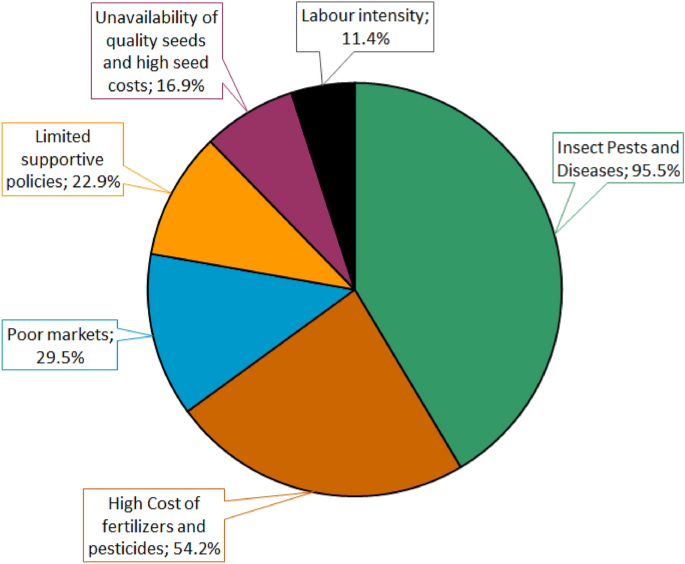
Major constraints to vegetable farming in the study area.
Occurrence, incidence and severity of soil-dwelling insect pests
The study revealed five typical soil-borne pests in major vegetable growing areas. These were: cabbage maggots/cabbage root flies (Delia platura), white grubs (Maladera sp.), click beetles (wireworms) (Agriotes sp.), onion maggots/onion root flies (Atherigona orientalis), and sap beetles (Urophorus humeralis Fabricius) (Fig. 2). Cabbage maggots had the highest occurrence in the cabbage-growing upper highland AEZs (UH1) in Nyandarua and Kiambu. White grubs and wireworms occurred most in upper highland AEZs (UH1 and UH2) in Nyandarua, Nakuru, and Kiambu (Fig. 2). However, onion maggots were prevalent in both lower and upper highland AEZs (UH2, LH3, and LH4) in Nakuru and Nyeri. Sap beetles were also identified on mature bulb onions from Nyeri (UH2). The influence of AEZ on pest occurrence was statistically significant (χ2 = 41.13, df = 20, p = 0.004). Despite being a central onion-growing zone, the study did not reveal any soil-borne insect pests of economic importance in Kajiado.
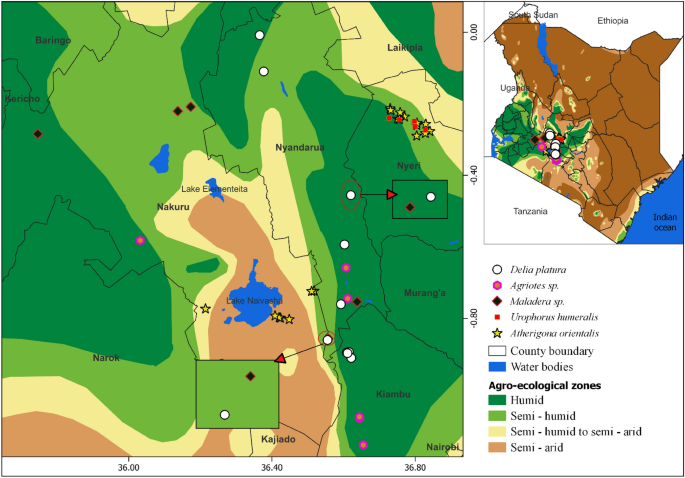
Distribution of soil-dwelling insect pests across various agro-ecological zones of Central Kenya.
Delia platura had a significantly higher incidence in cabbage farms in Nyandarua compared to Kiambu (t = 1.89, df = 8, p = 0.041). Maladera sp. and Agriotes sp. had a relatively low incidence in Nyandarua, Nakuru, and Kiambu, with a statistically similar occurrence across the three counties (t = 0.10, df = 11, p = 0.92) (Fig. 3). A. orientalis had a significantly higher incidence in Nakuru than in Nyeri (t = 3.22, df = 8, p = 0.01), whereas sap beetles were only detected in Nyeri (Fig. 3). The incidence of sap beetles and onion flies in Nyeri was statistically similar (t = 2.13, df = 15, p = 0.296).
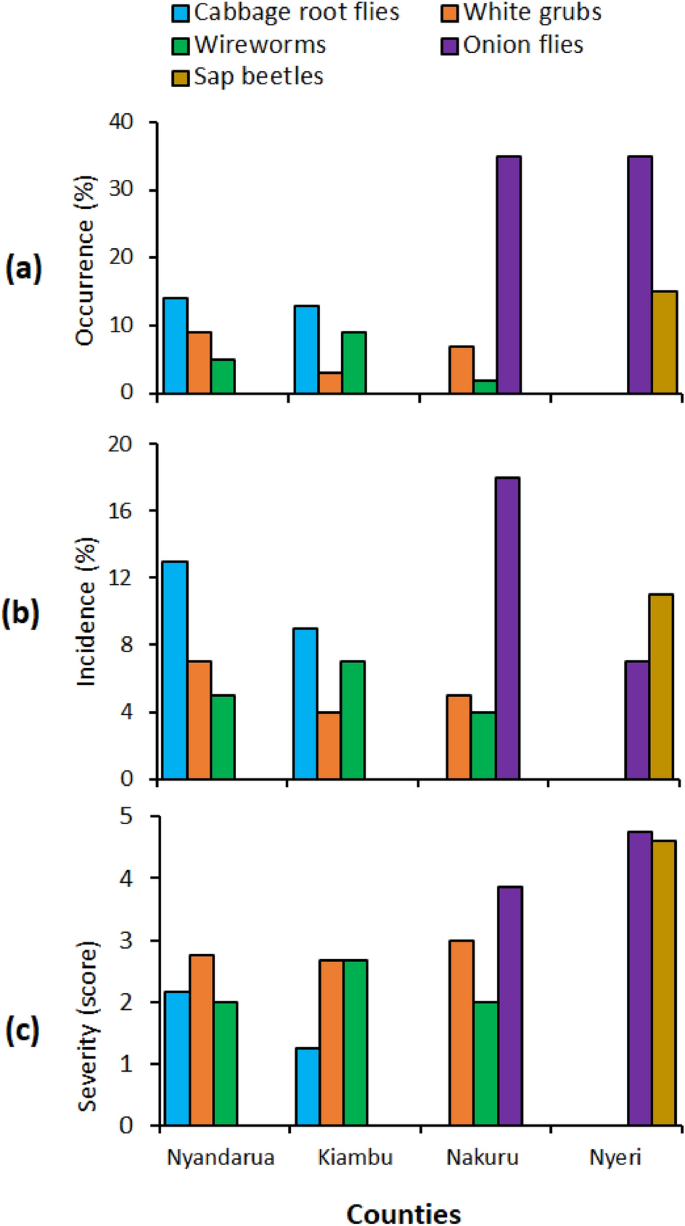
Occurrence (a), incidence (b), and severity (c) of soil dwelling insect pests in the five counties.
In cabbage fields, the damage index ranged between 1.3 and 3.0. White grubs had a higher damage index in Nyandarua, Kiambu, and Nakuru compared to wireworms, but the difference was not statistically significant (t = 2.23, df = 10, p = 0.149) (Fig. 3).
Delia platura had a moderate damage index with higher severity of infestation in Nyandarua compared to Kiambu (t = 2.45, df = 6, p = 0.022). High damage indices were observed in onion fields; A. orientalis and U. humeralis had a significantly higher damage index in Nyeri than in Nakuru (t = 2.31, df = 8, p = 0.04). It was noted that the damage due to U. humeralis infestation occurred in association with fusarium basal rot, which caused severe wilting and death of plants. The damage indices of sap beetles and onion flies in Nyeri did not vary significantly (t = 2.45, df = 6, p = 0.608).
Factors influencing the incidence and severity of soil-dwelling pests
The education level of farmers was weak positive correlation with the incidence and severity of soil-borne pests in onions and cabbage (Table 1). Agroecological zones were moderately correlated with pest incidence, while altitude had medium and significant negative relationships with pest incidence and severity, respectively. Nevertheless, the mono-cropping system had a weak positive but significant relationship with the damage index compared to a mixed-cropping system that exhibited a non-significant relationship. The level of farmers' awareness of soil-borne pests had a significant and medium negative relationship with both pest incidence and damage index. The frequency of pesticide application had weak correlation with pest incidence and severity. Furthermore, the pest incidence and damage index had a weak but significant negative correlation with crop yield (Table 1). The study revealed a moderate positive correlation between cabbage variety and pest incidence, and a weak positive correlation between onion varieties and pest incidence (Table 1). Crop yield had a medium and significant negative correlation with pest incidence and severity.
Morphological characteristics of the collected insects
Cabbage root fly (Delia platura), have a greyish body about 5 mm long, no wing coloration, and a moderately setose body (Fig. 4a–c). The apical posteroventral seta on the hind tibia matches the adjacent seta; the propleuron is bare; the upper calypter is larger than the lower calypter; and the cercus is elongated and oval. The onion flies (Atherigona orientalis) have a dark-brown to black antennae and palpi, pale grey pruinose thorax, sublateral black spots on the third, fourth, and fifth abdominal tergites (Fig. 4d–f). Their body length is about 4 mm with coarse reticulation ventral side and short leg bristles bare arista.
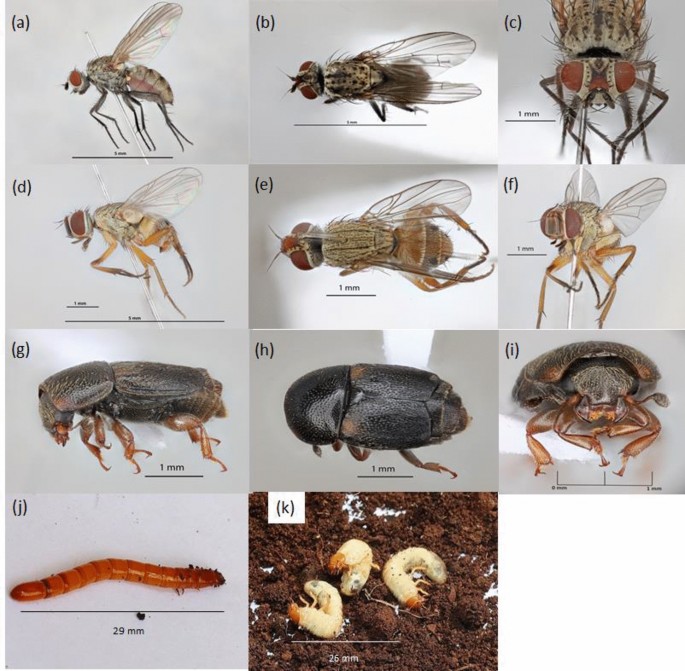
Soil-dwelling insect pests identified in major vegetable growing areas of Kenya. Delia platura: ventral (a), dorsal (b), and anterior views (c); Atherigona orientalis: ventral (d), dorsal (e) and anterior views (f); Urophorus sp.: ventral (g), dorsal (h) and anterior views (i); Agriotes sp. (j), and Maladera sp. (k).
Sap beetles (Urophorus humeralis) have a broad head that is narrower than the pronotum (Fig. 4g–i). They have truncate elytra with three exposed chitinised dorsal segments and apically located yellow patches on both elytrons. They have moderately short club-shaped antennae and their mandibles with tooth-like structures on the inner side behind the apex. They have a broad lacinia bearded on the inner margin and transverse prothorax almost as wide as the elytra. The wireworms (Agriotes spp.) have straight body, 29 mm long, and are dark yellow in colour (Fig. 4j). They have nine abdominal segments that are visible dorsally, with the ninth segment terminating in a blunt point with two "eye spots". Their setae are centrally located on the dorsum of the 9th segment, the 10th segment bears the anus and lies ventrad to the 9th segment. The frontoclypeal is lyre-shaped while their labium and maxillae are fused and the mandible bears tooth-like structures on the dorsal cutting edge.
The white grubs (Maladera spp.) have body length of 26 mm, 2.6 mm wide smooth yellow cranium and well-developed mesothorax legs (Fig. 4k). The apex of mandible and precoileae sutures are dark brown while the clypeus is subtrapezoidal with the anterior margin slightly shorter than the posterior margin. The labrum has a medial ridge, whereby the first to third abdominal segments are slightly thicker than the other abdominal segments and the teges of raster make up about half of the posterior half (Fig. 4k).
Molecular characteristics of cabbage and onion flies
The onion fly samples were positively characterised using mitochondrial COI gene, and their sequences linked to publicly available Atherigona orientalis COI sequences with identity similarities of ≥ 99% (Table 2), while the cabbage fly samples linked to Delia platura with identity similarities of ≥ 97%. For the mitochondrial COI gene region, both GenBank (NCBI) and BOLD queries gave similar identities. The D2 region of 28S large subunit rDNA corroborated the characterisation achieved by the mitochondrial COI gene region, whereby the Delia platura linked with ≥ 99% similarity (Table 2). However, the D2 region of 28S rDNA could only resolve the onion pests up to genus level with ≥ 97.56% similarity. The Atherigona orientalis sequences generated in this study were submitted to GenBank and assigned accession numbers (OQ835541–OQ835545 and OQ832304–OQ832304) while Delia platura sequences were assigned GenBank accession numbers OQ835546–OQ835550 and OQ832299–OQ832303 (Table 2).
Management of insect pests
Almost all of cabbage and onion farmers in the study area relied on chemical pesticides to control insect pests (Fig. 5). About half of the farmers demonstrated knowledge and utilisation of crop rotation in the management of both insect pests and diseases of cabbage and onions. Other methods of insect pest management included rogueing, elimination of damaged crop residues, and destruction of weed hosts (Fig. 5). Generally, the application of botanical pesticides and traditional pest management approaches was limited. There was a weak negative correlation between pest management approaches and the incidence and severity of soil-dwelling pests except for the control of relative weeds, which showed no correlation (Table 3). There was a significant positive correlation between absence of pest control and the occurrence of soil-dwelling pests (Table 3).
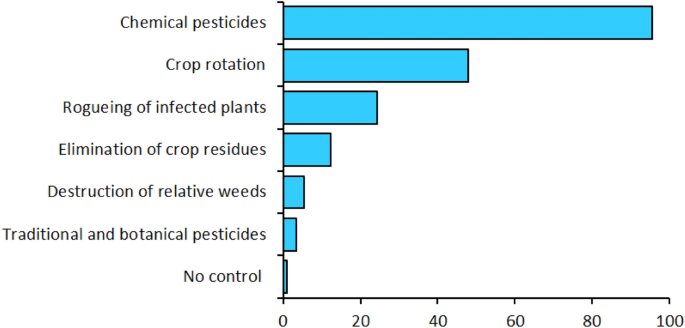
Pest management approaches used in major vegetable production areas of Kenya.
Alpha-cypermethrin, lambda-cyhalothrin, imidacloprid, beta-cyfluthrin, and acetamiprid were the most commonly applied chemical pesticides by cabbage farmers in Nyandarua, Nakuru, and Kiambu (Fig. 6). Pesticides with profenofos and cypermethrin were also common in Kiambu and Nakuru, while beta-cyfluthrin and chlorpyriphos were only used by farmers in Kiambu (Fig. 6). It was noted that a significant fraction of farmers in Nakuru and Nyandarua were unaware of the insecticides they used in pest management. The difference in pesticide use across the three cabbage-growing counties was statistically significant (χ2 = 54.87, df = 22, p < 0.001). Male farmers were more likely to use pesticides compared to their female counterparts, but the relationship between gender and pesticide use was not significant (χ2 = 9.92, df = 11, p = 0.537). Whereas pesticides were mostly used by farmers with primary and secondary school education, there was no significant relationship between the choice of pesticide and level of education (χ2 = 41.57, df = 22, p = 0.007).
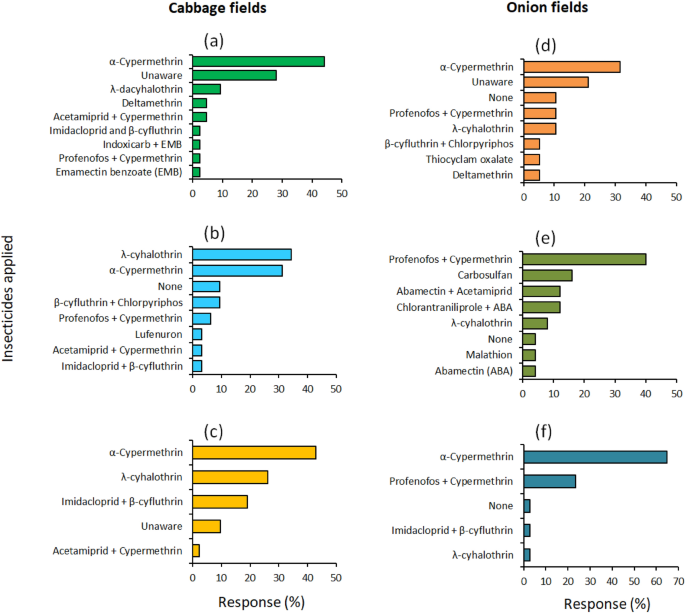
Insecticides used in cabbage (a–c) and onion fields (d–f) in Nakuru (a and d), Kiambu (b), Nyandarua (c), Kajiado (e), and Nyeri (f).
In onion fields, insecticides with profenofos and cypermethrin as active components were the most used by farmers in Nakuru, Kajiado, and Nyeri, while alpha-cypermethrin was predominantly used Nyeri and Nakuru (Fig. 6). Carbosulfan, chlorantraniliprole, abamectin, and acetamiprid were commonly used in Kajiado (Fig. 6). A considerable fraction of farmers in Nakuru, Kajiado, and Nyeri did not apply any synthetic pesticides. In Nakuru, however, 1 in 5 farmers were unaware of the names of pesticides used in their farms (Fig. 6). There were significant differences in the pesticides used by onion farmers in the study area (χ2 = 71.46, df = 26, p < 0.001). However, the relationships between gender and education level, and the choice of pesticide used in onion fields were not significant (gender: χ2 = 13.50, df = 13, p = 0.41, education level: χ2 = 39.43, df = 39, p = 0.451).
Frequency of pesticide use
The frequency of weekly application of insecticides was predominant in Kajiado, while bi-monthly application was most common in the other areas (Fig. 7). Although farmers with primary education were more likely to apply insecticides weekly, the level of education did not have a significant relationship with the frequency of pesticide application in cabbage (χ2 = 18.47, df = 12, p = 0.102) and onion fields (χ2 = 9.12, df = 12, p = 0.691). Agroecological zone had a significant influence on the frequency of pesticide application in onion fields (χ2 = 99.95, df = 20, p < 0.001) but not in cabbage farms (χ2 = 38.64, df = 30, p = 0.134). Nonetheless, there was no clear relationship between frequent pesticide application and incidence of soil-borne pests (r = − 0.05, p = 0.729).
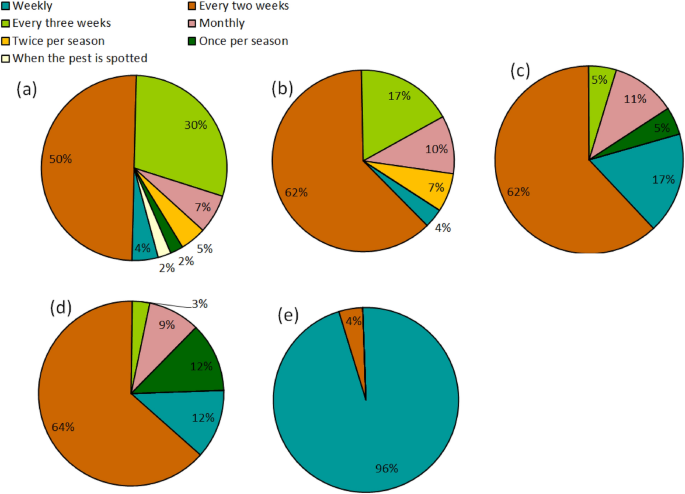
Frequency of pesticide application by cabbage and onion farmers in Nyandarua (a), Kiambu (b), Nakuru (c), Nyeri (d) and Kajiado (e).
Discussion
Occurrence, incidence and damage severity of soil-dwelling vegetable pests
The current study revealed high presence of soil-borne pests in vegetable farms across Kenya. The presence of several soil-borne pests, such as cabbage root fly (Delia platura) and onion root fly (Atherigona orientalis), white grubs (Maladera sp.), wire worms (Agriotes sp.), and sap beetles (Urophorus humeralis) agrees with previous studies that have reported soil-borne insect pests are a major biotic challenge to crop production in Kenya and beyond28,33,37,38,39. The larval stage of D. platura is polyphagous foraging on crops from different families including Brassicaceae, Amaryllidaceae, Poaceae, Fabaceae Apiaceae and Cucurbitaceae, among others40,41,42,43,44,45. Previous observations have reported moderate to high damage by Delia platura Meigen, Delia radicum L. and Delia antiqua Meigen in cabbage and onion fields, especially in nearctic and palaearctic regions22,46 The presence of adult D. platura in cabbage fields with no signs of larval infestation could be the third generation flies which emerge when the crop is in physiological maturity, thus causing the least or uneconomical damage47,48,49. Furthermore, application of broad-spectrum pesticides and unfavourable climatic conditions, such as the dynamic temperatures might have reduced egg production, enhanced egg predation and caused insect starvation48.
The current study found high incidence of onion maggot with damage index scores of 4 (considerable damage and infestation) and 5 (very high infestation levels/wilted and dead plants) in lower and upper highland AEZs (UH2, LH3 and LH4). This aligns with previous cases reported in Pakistan, where infestation ranges from 25 to 85% in melon fruits50. Atherigona orientalis is a polyphagous pest that feeds on plant materials damaged by other pests, but it can also be a primary pest in Solanaceae vegetables. For instance, A. orientalis is a major pest of Capsicum annuum in Nigeria, causing severe damage to both ripe and unripe pepper fruits, whereas the pest has been found on tomatoes and garlic chives in Korea51,52. Whilst A. orientalis was first recorded in Kenya (Kilifi) in 1999 by Robert S. Copeland, this is the first report of the insect as a major host of onion in the country. A. orientalis has a broad distribution globally and has previously been reported in afrotropical, nearctic, neotropical, Indo-Malayan, and Australasian regions as a major pest of cauliflower and cabbage (Brassica oleracea L.), orange (Citrus sinensis L.), bell pepper (Capsicum annuum L.), tomato (Lycopersicon esculentum Miller), and melon (Cucumis melo L.), Sorghum bicolor L. Moench and Phaseolus spp.52,53,54. The absence of onion root flies in lower midland zone (V) of Kenya can be attributed to the semi-arid agro-ecological conditions characterised by low altitude (970–1390 m), annual mean rainfall (420–520), and day temperature range of (23–28 °C), which may result in insect mortality due to desiccation55.
Other polyphagous pests, such as white grubs and wireworms were detected in three out of the five counties surveyed. Adult Maladera spp. can cause severe leaf damage to a broad range of horticultural crops, while the larvae feed on plant roots and cause substantial harm to horticulture and forestry56,57. The current study found a damage index score of 3 (average damage of 5–50%) and a high infestation of vegetables at the seedling stage, causing wilting and plant death. The current study did not detect any damage by the adult beetles, possibly due to their nocturnal feeding nature57. It should be noted that white grubs have been declared a biosecurity threat with a history of biological invasion58. The invasive species have also been reported in the United States, the Republic of Georgia, Turkey, Canada, and Rwanda37,58,59,60.
Previous studies have reported over 39 species from 21 genera of wireworms attacking potatoes, carrots, and sugar beets, especially in Europe and America20,61,62,63,64. While the damage intensity of wireworms on cruciferous crops has not been quantified in SSA, global studies have reported severe feeding damage on sweet potatoes62,63,65,66,67. Wireworms, soil-inhabiting larvae of click beetles (Coleoptera: Elateridae), are critical pests of arable and horticultural crops that feed on vegetable roots, causing retarded plant growth68,69. The consequent root damage hampers absorption of nutrients, leading to reddish or purple discoloration and the narrowing and curling of leaves70. Wireworms can cause 100% crop damage when infestation occurs during the seedling stage, leading to poor crop stands64. Studies in North America and Europe have identified numerous wireworm species with devastating effects on a broad range of crops62,68,71. However, the larvae of most sub-Saharan species remain undescribed, with no DNA sequence data.
Sap beetles or pineapple sap beetles (Urophorus humeralis) (Coleoptera: Nitidulidae) were detected in Kieni (upper Highland), causing severe rot and wilting (up to 100% crop damage) on mature onion bulbs. Similar results have been reported on the strawberry sap beetle, where crop damage on semi-ripe and ripe fruits was 100%, while unripe fruits showed over 82% damage following 48 h of exposure72. The pest was primarily detected alongside onion maggots, acting as a secondary pest of field onions in some cases. U. humeralis was also associated with fusarium basal rot of onions (Fusarium oxysporum Schlecht), indicating that the pest either attacks fermenting onions due to fusarium basal rot or is involved in the transmission of the disease. This observation aligns with Konam and Guest73, who found that Scolytidae and Nitidulidae beetles were attracted to Phytophthora palmivora disease lesions and facilitated disease transmission. Moreover, sap beetles are attracted to volatile compounds produced by Fusarium verticillioides in maize73,74,75, highlighting the need to establish the interaction between U. humeralis and onion crops infested with onion maggots and Fusarium basal rot.
The study demonstrated that farmers' education level and awareness of soil-borne pests has an integral effect on the incidence of soil-dwelling pests and crop production. These results conform to previous findings, which reported a relationship between farmers' education and the choice of crop variety, time of planting, crop husbandry, pest management practices, technology adoption, crop productivity76,77,78,79,80,81. Nevertheless, the high preference for hybrid vegetable varieties could be associated with their tolerance to pests. Moreover, previous studies have demonstrated substantial inclination towards improved vegetable varieties due to qualities such as high yield, compactness, early maturity, disease resistance, prolonged shelf life, and strong pungency for onions82,83,84.
Management of soil-dwelling pests
The current study revealed that almost all vegetable farmers in the study area rely on chemical pesticides to control pests. This is in agreement with previous studies, which revealed that 70–95% of Kenyan farmers use synthetic pesticides for the management of vegetable and fruit pests85,86. The absence of soil-borne onion insect pests in Oloitokitok could be largely attributed to the high frequency of pesticide application observed during the study, whereby most farmers applied pesticides weekly and in excess doses. The high frequency of application in excessive dosage has been previously reported87,88 and could be due to the ease of access to chemical pesticides at a low cost from neighbouring Tanzania. It was noted that some of the commonly used pesticides, such as pyrethroids (lambda-cyhalothrin, alpha-cypermethrin, and beta-cyfluthrin) and neonicotinoids (imidacloprid), are moderately hazardous to human health and the environment, according to the WHO classification (WHO II) (Table 4)89. Moreover, a quarter of the farmers interviewed were unaware of the specific product names of the pesticides used on their farms. Inadequate knowledge on pesticide use greatly contributes to excessive application, which could lead to pesticide toxicity, pest resistance, and ecosystem damage.
Past studies have reported high usage of pyrethroids and organophosphates in controlling insect pests in Kenya86,90,91,92. Although chemical application, crop rotation and rogueing enhanced pest suppression, the impact was not significant when applied in isolation. The low efficacy of insecticides draw attention to the possibility of pesticide resistance by soil-borne pests of cabbage and onions. Soil-borne pests, especially the root maggots have demonstrated a remarkable capacity to resist against organic pesticides, especially when applied in excess14. Poor pesticide use characterized by excessive dosage and short frequencies of application could lead to pesticide resistance. For example, farmers in Kajiado County expressed concern over above ground pests such as Thrips tabaci. The poor pesticide use observed in Kajiado has been previously reported93,94,95, and could also be attributed to low literacy levels; whereby, about three-quarters of farmers in the area had a primary school education or below. Therefore, there is a need to create awareness and build capacity among farmers on the effective use of pesticides for sustainable pest management. The absence of soil dwelling pests in Kajiado is probably due to basin irrigation, which might have resulted in drowning and/or suffocation, and the high frequency of insecticide application.
Almost half of the farmers used crop rotation as an additional approach to pest management. Non-chemical approaches to pest management, such as rouging of infected crops, destruction of relative weeds, use of traditional and botanical pesticides, and elimination of crop residues, are essential in the integrated management of insect pests, although farmers did not leverage these approaches96. Therefore, there is a need to promote integrated pest management approaches among vegetable farmers in Kenya for the effective management of insect pests as well as crop diseases.
Conclusion
The current study detected the presence of soil-dwelling insect pests with devastating effects on vegetable farming in Kenya. Delia platura and Antherigona orientalis are invasive polyphagous species with moderate to high occurrence in lower and upper highlands.
This is the first report of Antherigona orientalis as a major pest of onions and Delia platura as a potential pest of cabbage in Kenya. Other soil-borne pests identified across different agroecological zones include white grubs, wireworms, and sap beetles. The severity of the pest damage was high, especially in fields affected by Delia platura, Antherigona orientalis and Urophorus humeralis. It was noted that soil-dwelling pests which occurred in association, such as sap beetles and onion maggots aided in the transmission of plant diseases, especially Fusarium basal rot, causing further yield losses. Majority of the farmers apply broad-spectrum insecticides, primarily pyrethroids and organophosphates, on a weekly or fortnightly basis, but with little success. Although one in every two farmers used crop rotation to manage pests, integrated pest management approaches have not been embraced in vegetable cropping systems. The multi-infestation witnessed in onion production systems manifests the impact of climate change on crop production, whereby insect pests have expanded their host domain to survive. Moreover, the impacts of soil-dwelling pests have been exacerbated by a lack of accurate information and poor pesticide use, arising from the limited awareness and low education levels of most farmers. Thus, there is a need for rigorous classification of the prevailing soil-dwelling species, their phenology, and polyphagy in the context of tropical climate to design effective integrated pest management approaches.
Materials and methods
Characteristics of the study area
A field survey was conducted for three months (April to June 2022) to determine the occurrence, incidence, and severity of soil-borne pests of cabbage and onions in the major growing zones of Kenya: Nyandarua, Nakuru, Kiambu, Kajiado, and Nyeri counties (Fig. 8). The counties were selected to represent the major agroecological zones where cabbage and onions are grown: high altitude (Nyandarua, Nakuru, and Kiambu) and middle altitude (Nyeri and Kajiado) (Table 5). A total of 210 fields were surveyed during the study: 45, 65, 32, 34, and 34 fields in Nyandarua, Nakuru, Kiambu, Kajiado, and Nyeri, respectively. Apart from Nyandarua which had more female farmers, the other counties were dominated by male farmers. Most farmers were aged between 45 and 54 years and had attained at least a primary school education. Almost all farmers interviewed grew onions and cabbage on small land pieces of ≤ 1 acre, except in Kajiado County where nearly half of the farmers planted the vegetables on 2–4 acres (Table 6). Gloria F1, Pructor F1, and Victoria F1 were the three most common cabbage varieties in cabbage-growing counties, whereas Russet F1, Mang'ola, Malbec F1, and Red Coach F1 were the most grown bulb onion varieties in onion-growing areas (Table 7).
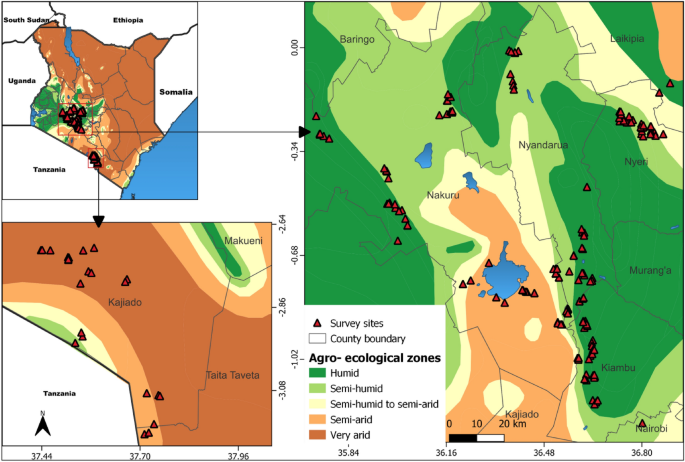
Survey sites and agro-ecological zones considered during the study.